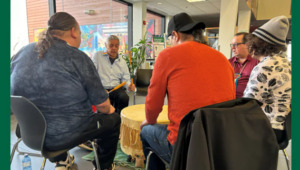The Pembroke Campus celebrated the naming of its Grandfather drum when Elder Barry Sarazin shared its name is Chijaack (pronounced Chee-Jack), a name that comes from the crane spirit. The drum is named after a Blue Heron.
Elder Barry Sarazin shared its name is Chijaack (pronounced Chee-Jack), a name that comes from the crane spirit. The drum is named after a Blue Heron.
Elder Sarazin told the audience of students and employees who gathered for the name revealing ceremony that “I had dreamed about a beautiful blue heron that flew down by the corner of the school,” when the name was presented to him by the spirit. Continue reading

 welcomed Randy Boissonnault, Minister of Employment, Workforce Development and Official Languages, to announce funding to assist with post-secondary education for Indigenous youth. The announcement included six million dollars for
welcomed Randy Boissonnault, Minister of Employment, Workforce Development and Official Languages, to announce funding to assist with post-secondary education for Indigenous youth. The announcement included six million dollars for